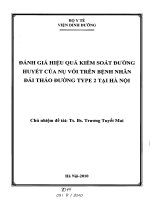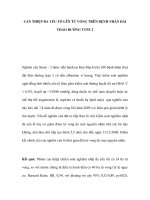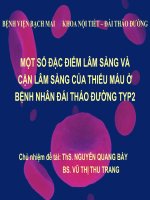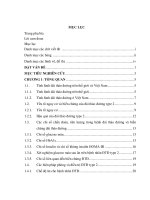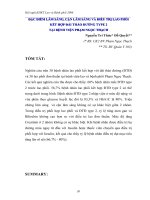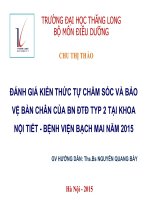ĐẶC ĐIỂM LÂM SÀNG, CẬN LÂM SÀNG CỦA LAO PHỔI Ở BỆNH NHÂN ĐÁI THÁO ĐƯỜNG TYPE 2 TẠI BỆNH VIỆN LAO VÀ BỆNH PHỔI THÁI NGUYÊN
Bạn đang xem bản rút gọn của tài liệu. Xem và tải ngay bản đầy đủ của tài liệu tại đây (327.57 KB, 6 trang )
<span class='text_page_counter'>(1)</span><div class='page_container' data-page=1>
<i>e-ISSN: 2615-9562 </i>
<b>CLINICAL AND SUBCLINICAL CHARACTERISTICS </b>
<b>OF PULMONARY TUBERCULOSIS IN PATIENTS WITH DIABETES </b>
<b>AT THAI NGUYEN TUBERCULOSIS AND LUNG DISEASE HOSPITAL </b>
<b>Cao Quy Tu*<sub>, Nguyen Thi Le, Duong Phuong Hieu </sub></b>
<i>TNU – University of Medicine and Pharmacy </i>
ABSTRACT
The relationship between patients with tuberculosis and diabetes has long been known. Numerous
studies have shown that diabetes alters the clinical manifestations and X-rays of pulmonary
tuberculosis. At Thai Nguyen Tuberculosis and Lung Disease Hospital, there has not been much
research on this issue, so we conducted this study with the aim of describing the clinical and subclinical
characteristics of pulmonary tuberculosis in patients Type 2 diabetes with research methods that
describe cross-sectional designs, combining retrospective and prospective studies. The study results
showed that the mean age ± SD of patients with tuberculosis with diabetes was 58 ± 13 years older than
patients with simple tuberculosis (42.27 ± 18) (p = 0.001). Mild fever in the afternoon, hiss, snoring rale
was more common in patients with pulmonary tuberculosis with diabetes (p <0.05), but more weight
loss was seen in the pulmonary tuberculosis group (p <0.05). Cave lesions and mediastinal lesions on
X-ray were more common in patients with tuberculosis with diabetes (27.9% and 62.8%, respectively)
compared with patients with pulmonary tuberculosis (6.5% and 43.5%, respectively).
<i><b>Keywords: Pulmonary tuberculosis; diabetes; clinical symptoms; subclinical symptoms; Thai Nguyen </b></i>
<i><b>Received: 12/11/2019; Revised: 03/4/2020; Published: 10/4/2020</b></i>
<b>ĐẶC ĐIỂM LÂM SÀNG, CẬN LÂM SÀNG CỦA LAO PHỔI Ở BỆNH NHÂN ĐÁI </b>
<b>THÁO ĐƯỜNG TYPE 2 TẠI BỆNH VIỆN LAO VÀ BỆNH PHỔI THÁI NGUYÊN </b>
<b>Cao Quý Tư*<sub>, Nguyễn Thị Lệ, Dương Phương Hiếu </sub></b>
<i>Trường Đại học Y Dược – ĐH Thái Nguyên </i>
TÓM TẮT
Mối liên quan giữa bệnh nhân mắc lao phổi và đái tháo đường đã được biết đến từ lâu. Nhiều
nghiên cứu đã chỉ ra rằng đái tháo đường làm thay đổi những biểu hiện lâm sàng và Xquang của
lao phổi. Tại Bệnh viện Lao và bệnh phổi Thái Nguyên cho tới nay vẫn chưa có nhiều nghiên
cứu về vấn đề này; do đó, chúng tơi tiến hành nghiên cứu này với mục tiêu mô tả đặc điểm lâm
sàng và cận lâm sàng của lao phổi ở bệnh nhân đái tháo đường type 2 với phương pháp nghiên
cứu mô tả thiết kế cắt ngang, kết hợp hồi cứu và tiến cứu. Kết quả nghiên cứu cho thấy tuổi trung
bình của bệnh nhân mắc lao phổi kèm đái tháo đường cao hơn 58 ± 13 tuổi so với bệnh nhân lao
phổi đơn thuần (42,27 ± 18) (p= 0,001). Sốt nhẹ về chiều, rale rít, rale ngáy thấy nhiều hơn ở
bệnh nhân lao phổi kèm đái tháo đường (p < 0,05), nhưng sụt cân thấy nhiều hơn ở nhóm lao
phổi đơn thuần (p < 0,05). Tổn thương hang và tổn thương thùy giữa trên X-quang thấy nhiều
hơn ở bệnh nhân lao phổi kèm đái tháo đường (lần lượt là 27,9% và 628%) so với bệnh nhân lao
phổi đơn thuần (lần lượt là 6,5% và 43,5%).
<i><b> Từ khóa: Lao phổi; đái tháo đường; lâm sàng; cận lâm sàng; Thái Nguyên </b></i>
<i><b>Ngày nhận bài: 12/11/2019; Ngày hoàn thiện: 03/4/2020; Ngày đăng: 10/4/2020 </b></i>
<i>* Corresponding author. Email: </i>
</div>
<span class='text_page_counter'>(2)</span><div class='page_container' data-page=2>
<b>1. Introduction </b>
The relationship between the patient with
tuberculosis (TB) and diabetes was known
2,000 years ago [0]. Increasing global
diabetes as well as in Vietnam is a major
challenge in controlling tuberculosis. People
with diabetes, especially type 2 diabetes, were
2-3 times more likely to develop TB disease
than people with simple tuberculosis [0].
There are many studies also showing that the
images on X-ray film in patients with simple
tuberculosis were different from those with
type 2 diabetes. Specifically, X-ray lesions of
patients with simple TB are common, image
lesions in the top of the lung and when
co-infected with 2 diseases, the X-ray lesions
were widespread and had a cavity in low
areas [0], [0]. In Thai Nguyen, so far, there
have not been many studies on clinical and
subclinical characteristics of patients with
tuberculosis and type 2 diabetes, so we
conducted research on the subject: “clinical
and subclinical characteristics of pulmonary
tuberculosis in patients with diabetes at Thai
Nguyen Tuberculosis and Lung Disease
Hospital” with the goal to describe the clinical
and subclinical characteristics of pulmonary
tuberculosis in patients with type 2 diabetes at
Thai Nguyen Tuberculosis and Lung Disease
Hospital.
<b>2. Subjects and research methods </b>
<i><b>2.1. Subject of research </b></i>
- Group 1: Patients with tuberculosis and
diabetes had 43 patients.
- Group 2: Patients with tuberculosis without
diabetes had 92 patients.
- The total number of patients selected was
135 patients.
<i>Criteria for choosing: </i>
- The patient agreed to participate in the study.
- Diagnostic criteria for Tuberculosis patients:
Patients diagnosed with Tuberculosis
according to the Ministry of Health's
diagnostic criteria are issued together with
Decision No.3216/QD-BYT on guiding
diagnosis, treatment and projections
Tuberculosis prevention (2018) [0].
- The patient has been diagnosed with
Diabetes type 2 according to the diagnostic
criteria of the American Diabetes Association
(2017) at medical facility [0].
<i>Exclusion criteria: </i>
- Patients with TB outside the lungs.
- Patients with diabetes who have TB disease
associated with HIV.
- Patients do not voluntarily participate in the study.
<i><b>2.2. Research location and time </b></i>
- Location: Thai Nguyen Tuberculosis and
Lung disease Hospital.
- Time: From January 2017 to March 2019.
<i><b>2.3. Research method </b></i>
- Descriptive design of retrospective
cross-sectional design and convenient search with
convenient sample.
<i><b>2.4. Sample size </b></i>
- 135 patients selected according to the above
criteria.
<i><b>2.5. Method of income data </b></i>
- Making medical records of research samples.
- Selecting patients according to the criteria
for selecting patients’ metric income.
- Based on medical records to find
information about age, gender, occupation,
geography, functional and physical
symptoms, register in a uniform form.
<i><b>2.6. Data processing method </b></i>
- According to the method of medical statistics
<b>3. Research results </b>
</div>
<span class='text_page_counter'>(3)</span><div class='page_container' data-page=3>
<i><b>Table 1. Demographic profile of patients participating in the study </b></i>
<b>General features </b> <b>Diabetes (n=43) </b> <b>No Diabetes (n=92) </b> <i>P value </i>
<b>Amount (%) </b> <b>Amount (%) </b>
Age
<40 4 (9.3) 37 (40.2)
0.001
40-54 11 (25.6) 27 (29.3)
55-69 20 (46.5) 19 (20.7)
≥70 8 (18.6) 9 (9.8)
Mean age ± SD 58.28 ± 13 42.27 ± 18
Gender Male 41 (95.3) 78 (84.8) 0.077
Female 2 (4.7) 14 (15.2)
Job
Officers and employees 5 (11.6) 1 (1.1)
0.003
Farmer 30 (69.8) 55 (59.8)
Other… 8 (18.6) 36 (39.1)
Income Poor, near poor 6 (14.0) 16 (17.4) > 0.05
Not poor 37 (86.0) 76 (82.6)
Nation
Kinh 33 (76.7) 54 (58.7)
> 0.05
Tay 6 (14.0) 18 (19.6)
Other... 4 (9.3) 20 (21.7)
<i>* P value ≤ 0.05, SD - standard deviation </i>
As shown in Table 1, in terms of gender, men account for the majority in both patient groups:
male tuberculosis with diabetes had 41/43 men (95.3%), pulmonary tuberculosis without male
diabetes had 78/92 (84.8%). There was no gender difference between the two groups of patients
studied (p> 0.05). About occupation, most of the researched patients had a farmer occupation: the
group of pulmonary tuberculosis with diabetes had 30/43 (69.3%), the group of pulmonary
tuberculosis without the farmer diabetes had 55/92 (59.8%). There was a statistically significant
difference in occupation of officials and employees between the two groups: the tuberculosis
group with diabetes 5/43 (11.6%) compared to the tuberculosis group without diabetes 1/92
(1.1%) (p <0.05). In terms of income, most of the patients studied in both groups had non-poor
income: the pulmonary tuberculosis group with non-poor diabetes had 37/43 (86%), the
tuberculosis group without the diabetes had 76/92 (82.6%). There was no statistically significant
difference in income status in the two study patient groups (p> 0.05). The Kinh group had the
highest prevalence in both research groups: 33/43 pulmonary tuberculosis with diabetes (33.7%),
and tuberculosis without 54/92 (58.7%).
<i><b>Table 2. Clinical symptom characteristics of study patients </b></i>
<b>Clinical symptoms </b> <b>Diabetes (n=43) </b> <b>No Diabetes (n=92) </b> <i>P </i>
<i>value </i>
<b>Amount </b> <b>% </b> <b>Amount </b> <b> % </b>
Afternoon fever 38 88.4 58 63.0 0.002
Lost weight 11 25.6 56 60.9 0.001
Moist rale 26 60.5 83 90.2 0.001
Hiss rale, snoring rale 16 37.2 4 4.3 0.001
<i>* P value ≤ 0.05 </i>
</div>
<span class='text_page_counter'>(4)</span><div class='page_container' data-page=4>
As displayed in table 2, patients with pulmonary TB without diabetes mellitus symptoms in the
lung had 83/92 (90.2%) more than the tuberculosis with diabetes with 26/43 (60.5%), the
difference was statistically significant (p = 0.001). There was a statistically significant difference
in the wheezing and sneezing symptoms in the lungs of two study patient groups: The
tuberculosis with diabetes group had more hissing and snoring symptoms than the non-diabetic
pulmonary tuberculosis group (37.2% compared to 4.3%) (p = 0.001).
<i><b>Table 3. Results of direct sputum smear </b></i>
<b>AFB </b> <b>Diabetes (n=43) </b> <b>No Diabetes (n=90) </b> <i><b>P value </b></i>
<b>Amount </b> <b>% </b> <b>Amount </b> <b>% </b>
Negative 21 48.8 48 52.2
0.72
Positive 22 37.2 44 47.8
Total 43 100 92 100.0
<i>* P value ≤ 0.05, AFB - Acid Fast Bacillus test </i>
Table 3 shows characteristics result of direct sputum smear of study patient. There was no
difference in the positive and negative AFB results between the two groups: The tuberculosis
group with diabetes had positive AFB 21/43 (48.8%) compared with the group without
pulmonary tuberculosis without 47/90 diabetes (52.2%) (p = 0.72) (Table 3).
<i><b>Table 4. Pathological images on X-ray film </b></i>
<b>Characteristics </b> <b>Diabetes (n=43), % </b> <b>No Diabetes (n=92), % </b> <i>P value </i>
Cavernous lesions 22 (27.9) 6 (6.5) 0.001
Middle lobe 27 (62.8) 40 (43.5) 0.037
Upper lobe 21 (48.8) 59 (64.1) 0.092
<i>* P value ≤ 0.05 </i>
Table 4 shows characteristics of pathological
images on X-ray film of study patients.
Patients with pulmonary tuberculosis with
diabetes had more cavernous lesions than
patients with pulmonary tuberculosis without
diabetes (27.9% versus 6.5%), this difference
was statistically significant (p = 0.001). The
proportion of middle lobe lesions in patients
with tuberculosis with diabetes was higher
(62.8%) compared with patients with
pulmonary tuberculosis alone (43.5%).
Patients with pulmonary tuberculosis alone
had a higher lesion of the upper lobe (64.1%)
compared to patients with pulmonary TB with
diabetes (48.8%), but the difference was not
statistically significant (p = 0.092).
<b>4. Discussion </b>
Through this study, we found that patients with
pulmonary tuberculosis with diabetes had a
high average age, had mild fever in the
afternoon, wheezing, snoring was more
common, lesions of the middle lobe were high,
cavernous lesions predominate compared with
non-diabetic pulmonary tuberculosis.
</div>
<span class='text_page_counter'>(5)</span><div class='page_container' data-page=5>
incidence of type 2 diabetes was higher for
women than for men [0]. However, when the
patients were co-infected with tuberculosis
and type 2 diabetes, the proportion of men
encountered more than women. Many studies
have raised the question that "Why is the
incidence of tuberculosis in type 2 diabetics
more common in men?" but so far has not
been explained clearly about the profession in
our research, the professions are aggregated
and divided into groups: officials, farmers,
other professions. The results in Table 1 show
that the incidence of farmers in both groups is
higher. Specifically, in the co-group with 2
diseases is 69.8%, the group with pulmonary
tuberculosis is 59.8%. In the group of
officials and employees, relatively low
percentage. There is a statistical difference
between the farmer group and the group of
officials and employees (p = 0.003). Our
study is different from Nguyen Huy Dien
(2014), the group of workers and employees
is 42.1%, accounting for the highest
proportion, the group of farming is 38.6%,
non-occupation 19.3% [0].
Clinical symptoms are statistically
significant in the frequency of afternoon
fever, weight loss, whooping rale, snoring
rale symptoms Patients with pulmonary
tuberculosis with diabetes have higher
afternoon fever, snoring and snoring, but
their weight loss is lower than that of
patients with pulmonary tuberculosis alone.
Our study is different from that of Nguyen
Trong Khoa, Tran Van Sang et al. (1997):
Symptoms of pulmonary tuberculosis in
diabetic patients are similar to pulmonary
tuberculosis, in which cough, sputum is
70.3%, hemoptysis 31.5%, afternoon fever
64.8%, weight loss 70.3% [0]. Nguyen Huy
Dien (2014), coughing up sputum 95.4%,
dry cough 74%, coughing up blood 9.6%,
chest tightness 92.8%, shortness of breath
36.1%. Lungs have a ragged 94% [0].
Regarding the direct sputum results in our
study, there was not statistically significant
difference in positive and negative AFB
results between the two groups: The
pulmonary tuberculosis group with diabetes
was negative 21/43 (48.8%), positive 22/43
(51.2%) compared with the non-diabetic
pulmonary tuberculosis group with negative
47/90 (52.2%), positive with 43/90 (47.8) (p
= 0.72). According to Phan Thanh Dung et al.
(2012) studying the characteristics of
pulmonary tuberculosis in patients with
diabetes, the rate of AFB (-) in patients with
tuberculosis and diabetes was 42%, much
higher than that of the group without
pulmonary TB 16% (p = 0.02) [0].
Regarding the image of pathological lesions
on X-ray film, in this study we found that
patients with pulmonary tuberculosis with
type 2 diabetes had more cavernous lesions
than patients without pulmonary tuberculosis
(27.9% compared with 6.5%), this difference
is statistically significant (p = 0.001) and
patients with pulmonary tuberculosis with
type 2 diabetes have high rate of lobular
injury between lungs on X-ray film is high
27/43 (62.8%), compared to patients with
pulmonary tuberculosis without diabetes
40/92 (43.5%), the difference was statistically
significant (p = 0.037). Our findings in this
study are similar to those of Perez-Guzmαn et
al, [0] and Cavalcanti et al [0]. In contrast,
several studies show no apparent radiological
differences between patients with tuberculosis
and diabetes without diabetes [0],[0], [0].
<b>5. Conclusion </b>
</div>
<span class='text_page_counter'>(6)</span><div class='page_container' data-page=6>
REFERENCES
<i>[1]. Prakalapakorn, and S. Grace, The Role of </i>
<i>DOTS therapy in Tuberculosis Control in </i>
<i>Bangkok, Thailand, Fulbright Researcher </i>
College of Public Health, Chulalongkorn
University, 2000.
[2]. B. I. Restrepo, and L. S. Schlesinger, “Impact
of diabetes on the natural history of
<i>tuberculosis,” Diabetes Research and Clinical </i>
<i>Practice, vol. 106, no.2, pp. 191-199, 2014. </i>
[3]. R. C. Zdo et al, "Characteristics of elderly
tuberculosis patients in Recife, Brazil: a
contribution to the tuberculosis control
<i>program," J. Bras. Pneumol., vol. 32, no. 6, pp. </i>
535-543, 2006.
[4]. C. Perez-Guzman et al, "Progressive
age-related changes in pulmonary tuberculosis
<i>images and the effect of diabetes," Am. J. </i>
<i>Respir. Crit. Care Med., vol. 162, no. 5, pp. </i>
1738-1740, 2000.
<i>[5]. Ministry of Health, The decision to issue </i>
<i>guidance on the diagnosis, treatment and </i>
<i>prophylaxis of Tuberculosis (issued cream </i>
<i>according to intent 3126 / QD - BYT dated 23 </i>
<i>May 2018), 2018. </i>
<i>[6]. International Diabetes Federation, IDF annual </i>
<i>report 2017, Belgium, 2017. </i>
[7]. H. D. Nguyen, "Clinical and subclinical
characteristics of pulmonary tuberculosis in
patients with type 2 diabetes in Hai Phong
Tuberculosis and Lung Diseases Hospital for 5
<i>years from 2010-2014," Journal of Practical </i>
<i>Medicine, vol. 914, no. 4, pp. 11-16, 2014. </i>
[8]. T. K. Nguyen et al, "Comment on some clinical
and subclinical characteristics in 54 patients with
tuberculosis and tuberculosis for treatment at
Tuberculosis and Lung Diseases Institute from
<i>September 1991 to April 1996," Medical </i>
<i>research, vol. 2, no. 2, pp. 8 – 12, 1997. </i>
[9]. T. D. Phan, T. V. Phan, T. H. L. Nguyen, and
C. L. Nguyen, "Features of pulmonary
tuberculosis in patients with diabetes in An
Giang hospital's tuberculosis department",
Proceedings of scientific conferences 10/2012,
An Giang Hospital, 2012, pp. 172-179.
[10]. B. Alisjahbana et al., "The effect of type 2
diabetes mellitus on the presentation and
treatment response of pulmonary tuberculosis,"
<i>Clin. Infect. Dis., vol. 45, no. 4, pp. 428-435, </i>
2007.
[11]. F. Bacakoglu et al., "Pulmonary tuberculosis
<i>in patients with diabetes mellitus," Respiration, </i>
vol. 68, no. 6, pp. 595-600, 1997.
</div>
<!--links-->
